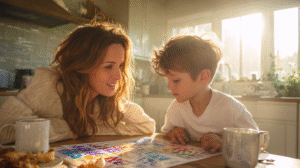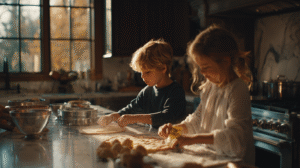
Morning Calendar Math: A Daily Routine to Build Number Sense
Morning Calendar Math: A Daily Routine to Build Number Sense As a former elementary math teacher turned homeschooling mom, I
“Mom, I’m bored!” That familiar phrase echoed through my living room. But instead of turning to screen time, we uncovered a powerful learning moment—math through play that quietly builds early math skills.
As a former math teacher now raising two young children, I’ve seen firsthand how everyday play can spark deep mathematical thinking. One afternoon, a casual cleanup session turned into a 45-minute math exploration with just a basket of mixed toys.
Sorting toys might look like play, but it’s one of the most effective ways to develop early math skills. It lays the groundwork for academic growth through classification, logic, pattern recognition, and early data skills—all essential for lifelong success in math.
Here’s how I transform ordinary toy time into meaningful mathematical learning, using activities that work for ages 2 through 7. No worksheets required—just curiosity and the toys already scattered across your floor.

Color sorting is where mathematical thinking begins. I spread blocks, toy cars, and plastic animals across our coffee table, watching my 4-year-old naturally reach for red items while my first-grader creates more sophisticated color families.
This preschool math activity builds classification skills that form the foundation of logical thinking. When children decide whether purple belongs with blues or reds, they’re making mathematical decisions about attributes and categories. I join in by asking, “What makes you put that toy in the blue group?”
Sorting toys by color also introduces early math skills and basic data concepts. We count items in each group, compare which color has more toys, and discuss our findings. These conversations help children articulate their mathematical reasoning naturally.
💡 Teacher Mom Tip: Start with primary colors, then challenge observation skills by asking for “different kinds of blue” toys. This develops nuanced classification abilities.
Moving beyond color opens exciting possibilities for early geometry exploration. My daughter loves arranging toy animals from smallest to largest, while my preschooler focuses on finding circular objects throughout our playroom.
Shape sorting for kids connects to their growing understanding of geometry without formal instruction. We hunt for round toys, then squares and triangles. This natural progression helps children internalize geometric concepts through hands-on discovery.
Size sorting offers incredible flexibility. Some days we arrange by height, others by width or length. These varied approaches help children understand that objects can be measured and compared multiple ways—a crucial concept for developing early math skills.
💡 Try This: Use comparative language naturally during play. Say “bigger than,” “smaller than,” and “about the same size” to build mathematical vocabulary organically.
This preschool math classification method often surprises parents with its sophistication, but children understand it intuitively. We create groups based on what toys do: vehicles together, building materials in another pile, pretend play items forming their own category.
My first-grader has developed impressive analytical skills through toy sorting logic. She explains her reasoning: “These all have wheels and move people around,” or “These are for building things up high.” Her thinking now reflects deep early math skills, extending beyond visual attributes to functional relationships.
This approach introduces early data analysis concepts. When we count toys in each category, we’re creating informal graphs and making comparisons between groups—building blocks of early math skills that will support future learning in statistics and algebra.
💡 Discussion Tip: Encourage your child to explain their categories aloud. Ask “What do these toys all have in common?” This verbalization strengthens logical reasoning.
Sensory math activities engage multiple senses while building classification skills. We separate wooden toys from plastic ones, soft stuffed animals from hard blocks, smooth items from textured surfaces. This hands-on approach reinforces that early math skills involve more than numbers and shapes.
My 4-year-old particularly enjoys this tactile learning math because it allows touching and manipulating while learning. He’s discovered that some toys feel cold, others warm, and textures change when squeezed. These sensory observations become part of his mathematical vocabulary.
Material sorting also introduces early science concepts alongside early math skills. Children notice properties like flexibility, weight, and durability as they handle different toys, building comprehensive understanding through multiple senses.
💡 Play Idea: Create “mystery sorting” games where children close their eyes and sort by touch alone. This builds classification skills while making activities more engaging and challenging.
Once children master single attributes, they’re ready for multi-attribute sorting challenges. We create categories requiring multiple characteristics simultaneously: “red vehicles” or “small, soft toys.” This advanced activity develops flexible thinking and problem-solving for kids.
My first-grader loves finding toys meeting two or three criteria. She searches for items that are blue, round, and small, celebrating when discovering a toy marble fitting all requirements. These mathematical discovery moments create genuine excitement about early math skills and learning in general.
This sorting type introduces early logical thinking patterns. Children learn “and” and “or” concepts as they decide whether toys belong in specific categories—foundational steps toward advanced early math skills and algebraic thinking.
💡 Challenge Game: Start with two attributes, gradually adding more as skills develop. Create “treasure hunts” for toys meeting specific criteria combinations: “Find a blue, soft, square toy!”
The benefits of sorting toys extend far beyond playroom fun. These activities build the early math skills children need for algebra, geometry, and data analysis throughout their academic careers. More importantly, they learn mathematics exists everywhere, not confined to textbooks and worksheets.
Every sorting session practices skills for organizing information, recognizing patterns, and solving problems creatively. These mathematical play moments create positive learning associations lasting a lifetime, building confidence in math—the number one factor in long-term academic success.
When my children sort toys, they’re developing essential thinking skills: logical reasoning, systematic organization, pattern recognition, and analytical comparison. These abilities transfer directly to school mathematics and beyond.
The magic happens when children don’t realize they’re doing math. They’re simply playing, exploring, and discovering—exactly how meaningful learning should feel.
💬 “We’re not just playing… we’re learning math with our hearts and hands.”

Morning Calendar Math: A Daily Routine to Build Number Sense As a former elementary math teacher turned homeschooling mom, I

Brushing Teeth Countdown: 5 Powerful Fun Tips for Kids As a former math teacher turned mom of two, I thought

Cooking Fractions for Kids: 7 Fun & Tasty Ways to Learn Math Last Tuesday, my 8-year-old son Jake stared at
*Also read:
25 Brilliant LEGO Math Activities to Build Number Sense and STEM Skills at Home
Teach Kids to Tell Time: The Clock Game Every Parent Should Try at Home